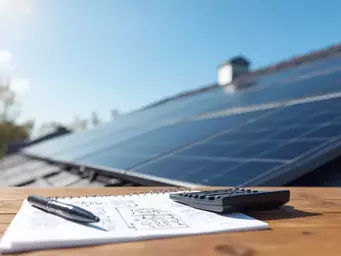Initial Assessment & Planning
- Review energy bills & usage patterns.
- Evaluate roof space, orientation, and shading.
- Plan system design & equipment selection.
Unlock expert insights on solar panel installation, energy savings, and government rebates for Australian homes and businesses. Join our community of informed solar enthusiasts!
Posted on: 2025-10-08
By: Evelyn Tran
As the demand for renewable energy solutions accelerates, understanding the solar panel installation process has never been more crucial. In 2025, Australian homeowners are embracing solar energy for both economic savings and environmental benefits. What if you could navigate this journey with confidence, equipped with the right knowledge?
Navigating the solar panel installation journey involves several crucial steps, from initial assessment to understanding financial incentives. This overview highlights the core stages and essential considerations for homeowners in 2025.
As an increasing number of Australians turn towards renewable energy, the significance of solar energy continues to grow. In 2025, homeowners are increasingly recognizing the benefits of installing solar panels, not just for reducing energy costs but also for contributing to a sustainable future. At Longi Solar Solutions, we understand that navigating the solar installation process can seem daunting, but with the right information, you can confidently embrace this transition!
In Australia, solar energy adoption has skyrocketed, driven by government incentives and the desire for energy independence. Homeowners now have access to a plethora of solar panel options that cater to various needs. This shift not only helps reduce electricity bills but also plays a crucial role in minimizing carbon footprints.
By understanding the solar panel installation process, you can make informed decisions that lead to long-term benefits. At Longi Solar Solutions, we’re here to help you understand each step involved in this journey!
The first step in your solar journey is evaluating your energy consumption and potential solar generation. Begin by assessing your energy bills from the past year to identify your average usage. You might also want to consider conducting a home energy audit, which can pinpoint areas for improvement. For a comprehensive guide on going solar, including how to assess your needs, you can refer to the Homeowner's Guide to Going Solar from Energy.gov.
Understanding your unique energy needs will help tailor a solar solution that fits your home perfectly. Remember, at Longi Solar Solutions, we’re here to assist you with valuable insights to maximize your solar potential!
Once you've assessed your energy needs, it's time to plan your solar system design. Consider factors like roof suitability, equipment choices, and the ideal design layout. The sizing of your system is critical; it should be aligned with your energy needs while optimizing the panels' orientation to capture sunlight effectively. Additional resources like the Solar Power in Your Community Guidebook can offer further insights into planning and implementing solar projects.
By carefully planning your solar system design, you ensure it operates efficiently and meets your energy goals. Our team at Longi Solar Solutions is always available to discuss options that align with your vision!
Choosing the right solar panel manufacturer is essential for a successful installation. Different manufacturers offer varying levels of quality, efficiency, and warranty options. Be sure to do your research to compare product offerings, keeping in mind the reputation and reliability of the brand. For detailed technical information and performance data, reports such as the one from NREL on Photovoltaic System Costs can provide valuable insights into product selection and cost considerations.
At Longi Solar Solutions, we can help you navigate these choices to find the best products for your specific needs. Making an informed decision now will pay off in energy savings for years to come!
We want to hear from you! Have you considered installing solar panels for your home? Share your thoughts below:
When considering solar panel installation, homeowners often face the choice between a DIY approach and hiring professional installers. Both options come with their own set of pros and cons. While DIY can be appealing for those looking to save costs, it's crucial to understand the complexities involved in ensuring compliance and safety.
As an experienced solar energy consultant, I always emphasize the importance of proper installation. Licensed professionals possess the necessary skills, tools, and knowledge to handle unforeseen challenges during the installation process. Here are some considerations:
Ultimately, the decision should reflect your comfort level with technical tasks, your budget, and your long-term energy goals. If you’re unsure, consulting with experts like Longi Solar Solutions can help clarify the best pathway for your solar journey!
In 2025, many Australian homeowners can take advantage of various financial incentives to help offset the cost of solar panel systems. Understanding these incentives can significantly impact your decision to go solar, so let's explore what’s available!
Staying informed about these incentives is essential! At Longi Solar Solutions, we are dedicated to guiding you through the application processes and ensuring you can maximize your financial benefits when transitioning to solar energy.
Feed-in tariffs and net metering are two important concepts for homeowners generating their own solar energy. Understanding how these systems work can unlock significant benefits and savings.
Feed-in tariffs allow you to sell excess energy generated by your solar panels back to the grid at predetermined rates, providing a steady income stream. Meanwhile, net metering enables homeowners to offset their electricity bills by receiving credit for the energy they contribute to the grid. Here are some advantages:
At Longi Solar Solutions, I encourage homeowners to fully explore these options. Understanding how feed-in tariffs and net metering work can enhance your overall solar experience and provide long-term financial benefits!
The first steps involve assessing your current energy consumption by reviewing past electricity bills and evaluating your roof space, orientation, and any potential shading. A home energy audit can also be beneficial.
When choosing a manufacturer, research leading brands, evaluate product warranties and performance ratings, and consider the long-term reliability and reputation of the brand to ensure a successful installation.
DIY installation can save costs but requires technical expertise, knowledge of compliance with regulations (like BCA), and ensures safety. Professional installation offers compliance, safety, warranties on work and equipment, and saves time and effort for homeowners.
In 2025, homeowners can benefit from solar rebates, Small-scale Technology Certificates (STCs), solar lease options, and Power Purchase Agreements (PPAs) to help offset installation costs.
Feed-in tariffs allow you to sell excess energy back to the grid for income, while net metering credits you for the energy you contribute, offsetting your electricity bills. Both systems lead to significant cost savings and promote energy independence.
As you navigate your solar panel installation journey, there are many factors to consider—from installation approaches to financial incentives. Remember, it's essential to assess your energy needs and explore options that best align with your budget and lifestyle. I invite you to connect with Longi Solar Solutions for expert guidance tailored to your unique situation!
Here is a quick recap of the important points discussed in the article:

 Ready to unlock the potential of solar energy for your home? Understanding the financial landscape o
Ready to unlock the potential of solar energy for your home? Understanding the financial landscape o
 As you contemplate the shift to solar energy, consider this: a comprehensive understanding of the co
As you contemplate the shift to solar energy, consider this: a comprehensive understanding of the co
 Choosing the right solar installer can significantly impact your renewable energy journey. Are you r
Choosing the right solar installer can significantly impact your renewable energy journey. Are you r